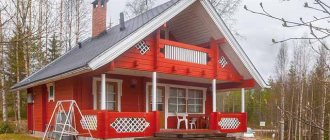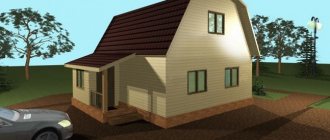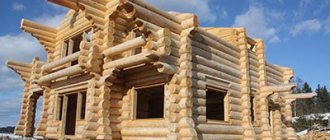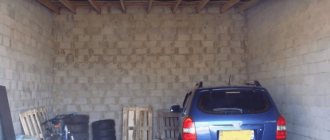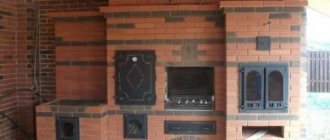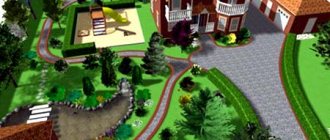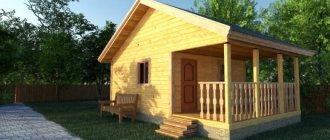In our country, we are so accustomed to traditional construction made of brick and concrete, focusing on SNiPs and GOSTs of the last century, that alternative types of construction are not even considered when choosing materials for building houses. Homes made from shipping containers are very popular in the USA and Europe. For them, this is a fairly standard design, which is much cheaper than capital construction. Moreover, such houses are in no way inferior in reliability to concrete ones.
House made from shipping containers inside
Advantages of container houses
Distrust also arises because such experimental construction appeared about twenty years ago. But construction experience and technology have already been sufficiently developed to create such housing for permanent residence.
Advantages and disadvantages
Pros:
- full-fledged housing from containers can be built in 1–3 months;
- a simplified version of the foundation will save money - columnar, screw, floor slabs;
- installation of containers in any position: side by side, on top of each other, at an angle, perpendicular;
- possibility of construction on any shape of terrain;
- choosing your own layout with virtually no restrictions;
- DIY construction without the involvement of specialized organizations;
- the ability to use it as a mobile home, that is, move it to a new site;
Transporting a house from a container - the tightness of the container provides protection against the penetration of rodents;
- seismic resistance: can be installed in areas with high seismological activity without the cost of reinforcement;
- using a container as an extension to a house made of other materials;
- expandable: you can add additional modules later;
- installation at any time of the year;
- originality of the structure.
Minuses:
- construction of rooms with a standard height of no more than 2.4 m;
- additional costs for lifting equipment for assembly;
- costs for installing high-quality ventilation and thermal insulation;
- the need for anti-corrosion protection of metal.
Bringing communications to the house
A residential building must be equipped with all the benefits of civilization, including water supply, sewerage, lighting and electricity in general.
Residential buildings made from metal containers are no exception to the rule. According to the prepared drawing, water supply, gas or electric heating are supplied to the house and electrical wiring is organized.
Note!
How to seal a stove so it doesn’t crack from the heat, what solution: review of the most effective methods + instructions
Why the bottom of the battery is cold and the top is hot - let's look at the reasons. Review of recommendations on what to do and how to fix it
How to insulate a dog house for the winter with your own hands and inexpensively - step-by-step instructions with photos and descriptions of all stages
An important parameter that should be given maximum attention is the organization of a high-quality exhaust system. Sufficient air circulation in the room will provide adequate protection against the proliferation of microorganisms and the accumulation of unpleasant odors.
Sea container sizes
In maritime transport, several options for ISO containers are used, differing in size:
- 20 feet;
- 40;
- 45;
- refrigerators.
45 feet are rare and reefer is too specific and expensive. The most common and popular are 20 and 40 feet. In the English system of measures, a foot is approximately equal to 30 cm. From here we get 6 and 12 meters, respectively.
Dimensions of popular containers suitable for construction
The actual size inside the 20-footer is slightly smaller and is 5,898 x 2,350, and the 40 is 12,093 x 2,330 x 2,372 m. Hence, the internal area of the empty module will be 13.8 and 28.2 m2, respectively.
To build a full-fledged house with an area of 60–120 m2, you need to use several containers. The modules can be arranged in 2–3 floors with a limited construction area. Containers are strong enough to build multi-story houses. Smaller blocks can be used as mobile workshops, change houses, temporary structures, country houses, etc.
Briefly about the main thing
A change house in a dacha often becomes the first home in which you will have to spend the night for several years before the construction of a real house. You can build it yourself in 1-2 days and save money. It is enough to make a simple foundation, weld or knock together a frame, install walls, floor and roof.
Companies offer ready-made houses of various sizes in the form of ready-made parts. It is enough to assemble the “constructor” in the right place. This is a good option for those for whom a standard house is enough, and who do not want to make calculations and purchase materials.
Question
Write in the comments what you think - is it worth making a metal frame in the change house or will a regular wooden frame suffice? Is there a change house at your dacha?
Device
The metal structure is welded from beams with longitudinal and transverse load-bearing elements. The side cladding and roof are made of corrugated steel sheets 1.5-2 mm thick.
Appearance and structure of a sea container
The floor is made of 2 longitudinal beams connected by cross beams to strengthen the structure. When covering the floor, metal, waterproof fiberboard, and plywood can be used.
For lifting and securing during transportation, the products are equipped with corner fittings, as well as holes for a forklift.
The name “marine” speaks for itself; the housing must be sealed. The doors are equipped with rubber seals to ensure tightness.
Materials required for the manufacture of metal cabins
- The main material for the frame is a profile pipe with dimensions of 40 by 60 mm, 40 by 40, 40 by 20;
- If you need to install additional insulation in your building, it is best to use material specialized for this purpose;
- Material for protection against the negative effects of steam;
- Moisture barrier;
- Metal sheet that has been pre-galvanized;
- Mounting rail;
- Fastening elements such as screws for metal and wood;
- A primer mixture that is suitable for use on metal surfaces;
- Flexible elements made of metal and used as corrugated sheeting;
- Electrical devices, wires, sockets, insulation. This will be necessary for the electrification of the cabins. Particular attention should be paid to insulation and grounding, since the change house is made entirely of a conductor of electricity - metal;
Design and layout of a metal shed for self-assembly - Structural elements such as windows and doors.
Shipping container houses
This type of construction is also called “semi-finished”. The building received this name because ready-made blocks with walls, ceiling and floor are used for construction, which do not need to be built separately.
A house made from a 20-foot container will be too small, but it can be converted into a small workshop or country house. A 40-foot container is approximately equal in area to a one-room apartment or studio apartment. If you need to create a full-fledged housing, you need to use several containers connected to each other. That is, you get a modular house.
Small house from a 20ft container
Metal containers have the shape of a regular parallelepiped. To play with the shape, some designers install modules at an angle to each other, or combine them with different sizes.
Laying insulation and insulating layers
Insulation of a container house is an aspect of construction work in which errors must be reduced to zero. Otherwise, myth number 2 will come true. It is recommended to carry out insulation with expanded polystyrene foam. You can attach thermal insulation in the form of slabs or apply the reagent directly by spraying. Container dwellings can also be insulated with polyurethane foam. It is necessary to install cladding panels on top of the insulating layer to give the house an attractive appearance and protect the insulation from moisture. If desired, layers of waterproofing can be laid in a similar way.
It is equally important to ensure that the inside of the building is insulated. It is necessary to insulate: places with cracks and large gaps. You also need to pay attention to areas with high thermal conductivity. If you ignore insulation, then in winter these areas will cool down the fastest. In container houses, such problems include almost the entire structure, so it is necessary to provide for the volumetric costs of thermal insulation. It is recommended to install internal insulation using plastic fasteners or liquid nails. Lay polystyrene foam boards on the floor.
What can be built
Due to their size and strength, containers can be used to create various buildings:
- Apartment – for the residents of our country, this project still seems strange, but it is gaining popularity.
- A workshop is an excellent option for small production.
- Country house - if used only in the summer, then no special insulation is required.
- A store is a suitable option for a small business. And over time, you can move the store to a new, more profitable location.
There is plenty of space in the workshop
Representative office
Small mobile store
- Flower pavilion is another type of mobile business.
- Garden house - for storing equipment and other supplies for the garden.
- Barn – can be used for keeping livestock, or as home storage.
Heating
Taking into account the climate of most regions of the Russian Federation, a housing project for year-round use should have a vestibule or mini-vestibule in the entrance solutions. In this case, heating with electric convectors will be the cheapest option.
The most expensive option is considered to be a gas tank with a gas boiler, the most budgetary is natural gas with an illogical heating device. In most regions, solid fuel stoves using coal, wood, briquettes, pellets, and other types of energy remain an acceptable solution.
Projects and planning
Many people think that a container house will be very narrow and have a standard layout - this is far from the case. Several containers connected together will help to expand the boundaries of space, between which you need to remove interfering partitions. It can also be a multi-story building with a spiral staircase.
The house project is drawn taking into account the dimensions of the selected module of 20 or 40 feet or a set of several modules. The structure should be designed taking into account the supply of communications and focusing on general standards.
Before you start building a house from shipping containers, you must obtain permits if the construction is major. If you plan to put the house into operation through BTI, it is necessary to comply with current standards. In this case, it is worth hiring a professional design organization.
Next, an estimate is drawn up that takes into account all the necessary building materials. Based on the weight, the required foundation is calculated.
Construction stages
First of all, you need to purchase one or more containers. They should definitely be checked for radiation, since it is in such containers that the remains of harmful radiation are collected. They must be free of dents and other defects. Before starting the installation of a house from containers, it is necessary to draw up a detailed project with a plan for the main work. You should decide in advance on the size and number of modules if a large family will live.
Foundation
Laying out the foundation is the very first and most important stage in construction. Installation on plain soil is impossible, since a heavy container will cause severe subsidence of the ground. In winter, the floors will be cold and the finishing materials will freeze.
When choosing a foundation option, it is necessary to take into account the size of the future house and the terrain. If this is an ordinary shed for temporary residence in the summer, a few foundation blocks will be enough. A residential building of several floors requires preliminary preparation of the foundation. For this purpose, a reinforced strip foundation is usually used. In regions with marshy soil, piles cannot be avoided.
Only a monolithic foundation can perform the functions of a reliable foundation. For it, a pit is first dug and filled with a mixture of cement, sand and water. For greater strength, various hardeners are added.
To fill the foundation, you can use a ready-made mixture. In this case, you will need to make a reinforcement frame according to the drawing, install formwork, and pour mortar. Special vibrating tools will help compact the concrete.
Corrosion and weather protection
Any metal structure (small cabin, two-story house) is susceptible to corrosion. It is in constant contact with the external environment - sun, water, wind. Inaction at the first appearance of signs of illness will lead to disastrous consequences.
The problem area will grow, gradually worsening the functional characteristics of the entire structure. A damaged structure will lose its attractive appearance and become dangerous for residents. You can protect it in several ways:
- Padding. All external surfaces are treated with special enamel, which fills cracks, chips and reliably protects the metal;
- Correct choice of installation location. It is better to erect the structure on a hill or an artificial rampart to minimize contact with the ground;
- Polymer coating. Doubles the service life of the container, repels moisture;
- Galvanization. The outer walls and roof are sheathed with galvanized sheets to reliably protect the structure.
Installing modules
After pouring the foundation, you must wait at least 25 days. When the concrete has matured, you can begin installing the containers. To do this you will need to resort to the help of a truck crane. The installed modules must be fastened together with iron corners, rectangular pipes using a welding machine or a gas generator.
The container space is divided into zones using plasterboard sheets in accordance with the layout. At the same stage, windows and doors are cut. Using modular blocks of different sizes, you can build a custom building with an unusual design.
Roof structure
All types of containers have ceilings, but they cannot be considered a full roof. The roofing is installed according to the standard scheme. The roof can be made of metal sheets, ondulin, wood. The material is chosen depending on the idea and overall design of the house. Installation takes place in several stages:
- Assembling a timber frame. Wide boards are fastened together using plumbing bolts and screwed to the container with self-tapping screws;
- Installation of rafters. The length of the boards should be sufficient to eliminate the need for splicing. The rafters are also attached with self-tapping screws;
- Installation of sheathing. For work, six-meter boards are used, which are then covered with a vapor barrier film;
- Laying galvanized sheets. It is imperative to provide space for ventilation.
External insulation of the building
Due to their structure and type of material, sea containers transmit sound well and do not retain heat. A house made from such modules must be insulated from the outside. External insulation is much more effective than internal insulation, since it completely eliminates heating of the metal. You can achieve better results if you use both options simultaneously.
Wall cladding from the street is done using corrugated sheets, siding, wood and other methods. Board materials are attached to the wooden sheathing with self-tapping screws. The space between the container wall and the decorative trim can be filled with mineral wool and filled with foam.
Utilities: electricity, gas, water and heating
The comfort of living directly depends on the availability and features of utilities. Competent design and high-quality installation will help extend the life of the house and reduce the number of emergency situations.
Engineering systems are one of the most important and costly components of any building. At the planning stage, the methods of laying pipes and cables, the necessary equipment, and the type of installation are taken into account. A certain amount is allocated for the work, which is 25-50% of the total planned construction costs. For the normal functioning of the house, the following communications will be required:
- Electricity. The wires are laid through special channels that run along the internal walls.
- Gas. Carrying out is possible if the gas pipeline is close.
- Water pipes. You will need to make your own well or connect to the system of the nearest settlement;
- Heating. More often they use a fireplace or a metal stove.
Home ventilation
Usually two ventilation holes are made, located opposite each other. A pipe is cut into the end of the container and led above the roof. This will ensure air flow. On the other side we make an outlet, install a fan and an exhaust hood.
For the area of one trailer, a device with a diameter of 100 mm will be sufficient. Control valves should also be installed. You can make two inflows at the ends, and an exhaust in the middle. The choice of option depends on the temperature outside, the number of residents and other factors.
Internal insulation and finishing
At the initial stage of finishing, the walls are thermally insulated. Then decorative surfaces are installed, plastered and painted. There are several ways to insulate a container from the inside:
- Thermal insulation with polyurethane foam. The sprayed material protects the metal from corrosion. A dense layer of polyurethane foam does not allow air to pass through and protects against noise;
- Polystyrene foam boards. Polystyrene foam with a dense structure can be mounted directly to metal walls or placed in the cells of the sheathing;
- Insulation with mineral wool. The material is laid on polyurethane foam. Then the sheathing is filled for further installation of gypsum boards and plywood.
The frame with insulation can be covered with any material. Lining and drywall will do. The joints of the sheets are glued with a construction bandage, then the entire surface is painted with latex-based water-based paint.
How to build a house from containers with your own hands
Once the project is ready, we begin construction. You just need to take into account the sequence of installation operations, which are practically no different from conventional housing construction.
Converting a container into housing takes place in several stages. First of all, this is installing the containers in the desired position and fastening them together. Then comes the installation of the necessary partitions, as well as the addition of the necessary structures to create a layout according to the preliminary plan.
Construction stages:
- Construction of a suitable foundation - after calculation and selection of the type, the foundation is arranged in accordance with known standards.
- Installation and strengthening of containers - special lifting equipment is used for these purposes.
- Anti-corrosion treatment – to ensure the durability of the building. It is necessary to pre-treat all metal with special anti-corrosion compounds.
- Insulation of walls and roofs – metal containers must be insulated. For this, mineral wool, polyurethane foam or expanded polystyrene are used.
- Communications supply - in addition to the installation of electricity, water supply, sewerage and heating, a special role should be given to the arrangement of good ventilation.
- Exterior and interior decoration is the final stage that gives the house its final appearance.
Advantages and disadvantages
Houses built from marine or cargo reusable containers are characterized by a number of significant advantages. One of the main advantages is the relatively low cost. For little money you can purchase a ready-made block that will become a small house, a separate room, or a floor. The building also has the following positive characteristics:
- Strength. Thanks to this quality, they are used in seismically dangerous areas, in places where hurricanes, tornadoes, and other natural disasters are observed.
- Light weight. The weight of the product is insignificant, so installation does not require a capital foundation.
- Speed of construction work. Construction of a house will not take much time; even complex structures can be completed within 2-3 months, including exterior and interior decoration.
- Mobility. If necessary, the residential building can be disassembled and reassembled, and transported to another location.
- Innovation and creativity. The original designs stand out due to their appearance.
- Durability. With proper care and periodic maintenance, the house will last a long time.
- Versatility and practicality. Blocks can be combined with other building elements and included in projects for concrete, brick, and wooden buildings.
- Protection from unwanted fauna. Insects and rodents will not be able to enter the sealed container.
- Possibility of expansion. At any time you can increase the living space or add a new module.
When choosing this option, it is worth considering its inherent disadvantages. The main disadvantages include:
- Toxicity. Elements intended for the transportation of goods are treated with chemicals that protect the surface from negative atmospheric influences. It is necessary to remove the toxic layer.
- Fixed parameters. It is impossible to change the height of the ceilings or the width of the internal space.
- Coefficient of thermal conductivity. The metal heats up very quickly and does not retain heat. Very good thermal insulation will be required.
- Tightness. The material does not allow air to pass through, does not “breathe”. For a comfortable stay, you should organize high-quality ventilation.
- Corrosion. To extend the service life, you will have to constantly inspect the condition of the surface and eliminate various defects.
- Technical condition. It is difficult to find packaging on the secondary market that meets the requirements and does not have significant flaws.
- Seasonality. Most projects are not designed for year-round living. Budget options are not suitable for the comfortable existence of a full-fledged family.
Layout
A 12-meter house is comparable in area to a studio apartment. When planning, you can focus on ready-made projects. There is a combined bathroom and a living room connected to the kitchen. This block has enough space to divide the space into areas for work and relaxation.
A small sea container is not well suited for use as a full-fledged home - it is quite difficult to create a comfortable layout for 12 m2. To visually expand the space, you can use mirrors. Such buildings are usually used as seasonal housing, or as additional modules to the main building.
Cost and construction costs
The cost of building a semi-finished product is much cheaper than standard housing. It depends on various factors. It includes a number of points:
- purchase of land;
- drafting;
- obtaining permission to construct a capital structure;
- area of the house, number of rooms, number of storeys;
- construction materials and transportation costs;
- rental of special equipment, construction personnel;
- engineering Communication.
The price of the finished product may vary. Buying a new product will cost more money than buying a used model. The technical condition of the container and the place of its sale are also taken into account. For example, in port cities you can buy inexpensively. The price depends on the type of product itself and its main parameters.
The cost of delivery may be commensurate with the price of the container. But the largest investments will be in the purchase of finishing materials and salaries of employees.
When building a good-quality house suitable for permanent residence, you should not skimp on insulation. Thermal insulation requires additional investment.
The cost of building a container will be 30-50% lower than building a house from traditional materials.
Modular house
Houses made from block containers can be permanent or collapsible for ease of transportation. The advantage of modular houses is the ability to replace a separate block of the house, which is impossible in a traditional building.
Modular house made of two containers of different sizes - 20 and 40 feet
The most standard version of a modular house is a one-story building with the connection of several modules. A more creative option is a multi-story building with the installation of an internal or external staircase. Installing a staircase outside the building helps to save useful space and use it for the necessary rooms.
A house made of 2 containers can be supplemented with a veranda or terrace. To do this, they need to be positioned perpendicularly and an open terrace should be built in the resulting corner space. Or install the containers in parallel at a certain distance, and between them place a covered veranda on an additional wooden flooring connecting the blocks to each other.
Roof
Reusable containers are stored in stacks in terminals, so they have a flat roof with a multiple safety margin for the load-bearing structures. This allows the developer to purchase a container for several types of roofing projects:
- flat roof - waterproofing with rolled fused bitumen material without organizing internal drainage;
- pitched roof - installation of a rafter system, cladding with ondulin, flexible and metal tiles, corrugated sheets;
- exploitable roof - EPDM film with loading of crushed stone, paving stones, organization of drainage;
- attic - due to the small size of the container, this option is only suitable for projects consisting of several assembly units.
The first option ensures the mobility of the building between objects, all the others - only within the site.
Container foundation
As already mentioned, the construction of container houses does not require the installation of a special type of foundation. The choice depends only on whether the construction will be permanent or mobile. The calculation takes into account the topography of the site and the type of soil. Additionally, you need to take into account the number of floors of the future house, as well as the weight of all modules used.
Low pile foundation under a mini-house
Columnar foundation under a modular house
Instead of a foundation, a flat area sprinkled with gravel is sufficient.
You need to understand that metal containers are very durable and will not sag in only one place, unlike concrete or brick. Therefore, when installing such housing, cheap types of foundations, such as columnar or screw, are sufficient. The use of stronger foundations is necessary only if the building is quite heavy, for example, when assembling modules into 2 floors.
Step-by-step instructions for building a house
Despite the stability of metal structures on any type of terrain, the condition of the land and soil must be checked before construction begins.
These actions are necessary mainly to calculate the depth and width of the foundation pour. The underlying soil is assessed for the presence of karst sinkholes and the depth of groundwater.
Note!
Chipboard: what is it? Types, application features, photos, sizes, thickness, explanation, manufacturers
Working pressure in the heating system in a private house: what it should be, how to create it, instructions for adjusting it yourself
Do-it-yourself potbelly stove: review of the most effective and economical potbelly stove, instructions, diagram, drawings, photos
Price
The cost of such housing (even taking into account finishing) is 30% less than the price of a finished house of classical construction. On average, building a house with an area of 55 m2 will cost from 800 thousand rubles. It should be taken into account that the total cost of such housing is influenced by such factors as:
- the cost of the land plot on which the finished building will be installed;
- costs for design and obtaining permits in case of capital construction;
- number of floors and total area;
- transport and lifting works;
- hiring specialists if it is impossible to carry out the work independently;
- communications costs;
- purchase of building materials.
Additionally, the cost is influenced by the fact whether the containers purchased for construction will be new or used, which will be cheaper. If the installation site is located far from the port where the shipping containers are located, the distance may increase transportation costs. It will not be possible to save on thermal insulation materials, since such a house, with year-round use, requires high-quality insulation. Finishing can also significantly increase the budget - this is the most expensive item in the estimated cost of any home.
History of container structures
double-circuit house covered with wood The idea of such an unusual container house project does not have an author. Not surprising. This is nothing new. What is more important is a creative approach to the structures used, design and finishing work. Adam Culkin was the first to successfully use containers as building blocks. His modern and beautiful home has a striking appearance that hardly echoes the primitive design.
a simpler one-story version of a container house
Having received significant savings by using used shipping containers, the talented architect was able to create a full-fledged monolithic house consisting of many rooms. The construction took three blocks. An architectural technique such as the use of identical panoramic windows united the containers into a single structure.
Reviews, videos
Despite numerous discussions among skeptics about the unsuitability of containers for full-fledged living, the owners of such houses speak well of their finished homes. Such budget housing does not break the budget of a large family, but can provide a separate room for each of its inhabitants. Those who cannot afford a full-fledged house made of brick or concrete speak well of cottages made from shipping containers. This option is much more profitable and convenient compared to a small, cramped apartment.
External skin
The sea container is initially sheathed on the outside with corrugated sheets. The industrial design of facades often does not suit the owner; claddings are used that imitate natural, artificial materials of high decorative value:
- log, timber - block house, lining;
- brick, stone – corrugated sheets with photo printing, siding.
To save internal space, it is rational to use external insulation of enclosing structures:
- ventilated facade - heat-insulating material is attached to the walls without gaps, then brackets are installed, a frame is hung on them, to which the facing materials are fixed;
- wet facade - the insulation is covered with a layer of decorative or textured plaster.
Due to the compact size of containers, construction is cheaper than classical technologies. The delivery time for objects is sharply reduced, since to build a cottage from large-scale assembly units than from traditional construction materials.
Useful tips for home improvement
Based on personal experience, the owners of such buildings give several recommendations for converting cargo containers into living quarters:
- A vestibule should be installed at the entrance to prevent cold from the street from penetrating into the building.
- Metal-plastic windows are equipped with adjustable valves for ventilation.
- Decorative and protective roller shutters are installed on the windows outside.
- Before installing the sea box, the concrete foundation should be covered with waterproofing material.
- You need to install a hygrometer inside and connect the ventilation system controller to it. It will automatically adjust performance to maintain humidity at the optimal level.
Design ideas
A container house designed in a loft, modern or high-tech style looks most organic. Minimalism, transparent or shiny (chrome) objects are welcome. Rooms with shelves and sliding glass doors and large windows look impressive.
A country house can be decorated in a country style by covering the inside and outside with wooden siding or a block house.
Big house.
